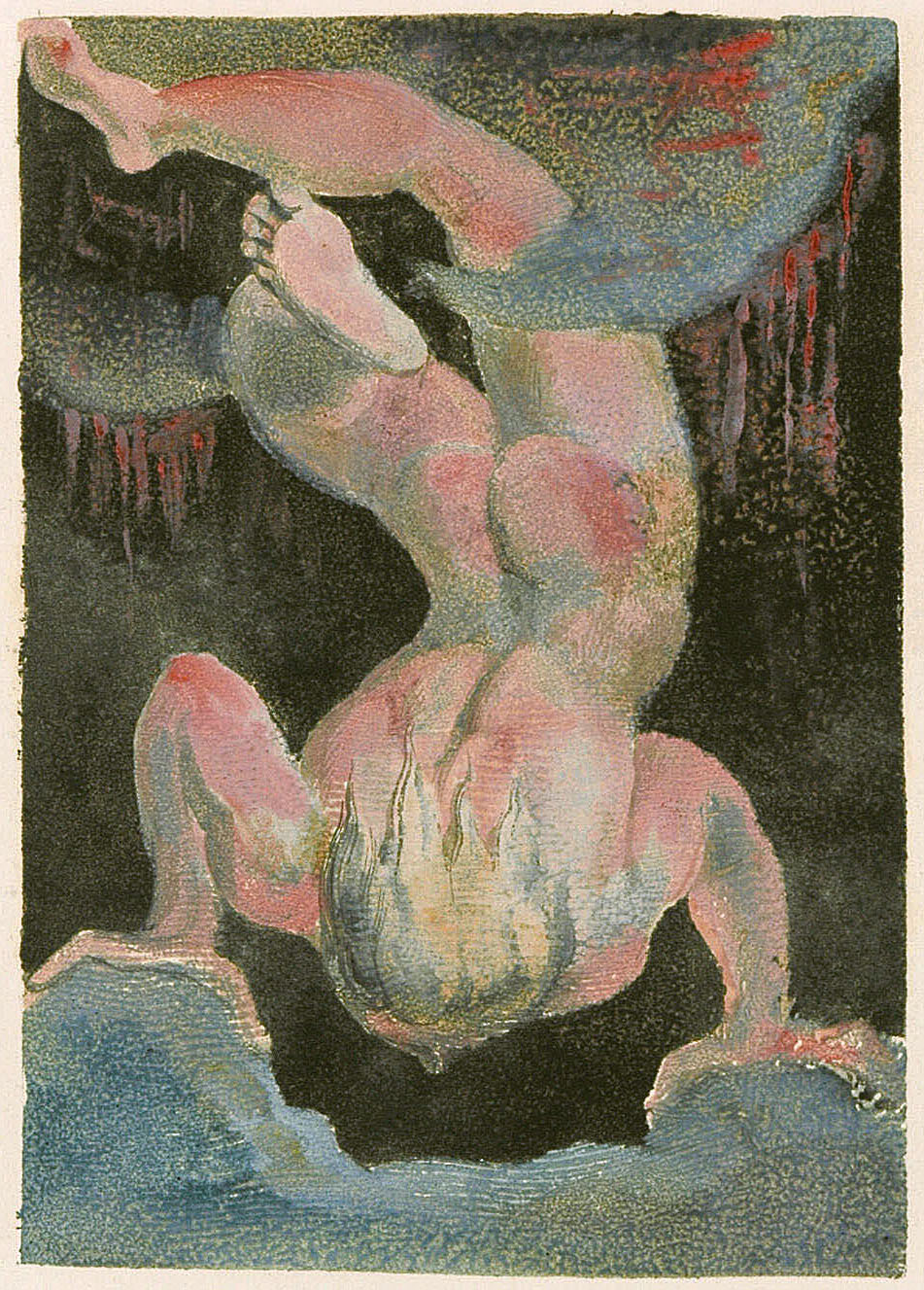The William Blake Archive is pleased to announce the publication of a digital edition of Blake’s The First Book of Urizen Copy J. This copy was acquired at an unknown time, probably in the nineteenth century, by the Royal Library, Vienna, and transferred in 1903 to the Albertina Museum, Vienna. However, it was not known to students of Blake until near the end of the twentieth century when the German Blake scholar and art historian Detlef Dörrbecker rediscovered it. This is the first time Copy J has been edited and reproduced in true-size, high-resolution images.
Copy J is the seventh of eight extant copies of Urizen to enter the Archive, joining Copies A, C, D, and F, all color printed in 1794, Copy B, printed on large paper as part of a deluxe set of copies of illuminated books in 1795, and Copy G, printed c. 1818, when Blake resumed printing illuminated books after a hiatus of many years. The First Book of Urizen comprises 28 shallowly etched relief etchings, though only Copies A and B contain all the plates and only Copy G, the last copy printed, dropped the word “First” from its title page, acknowledging that the volume was not part of a series, which Blake appears initially to have envisioned. The story of Urizen continues in The Book of Ahania and The Book of Los, the unique copies of which are in the Archive, but these books, both executed in intaglio and color printed in 1795, are smaller and much shorter.
Urizen Copy J, with 25 plates, was beautifully and extensively color printed—from both the surface and shallow portions of the relief plates—with Copies A, C, D, E, and F. The similarities and differences among impressions from the same plate can be examined by using the Archive’s compare feature, located under the image in the tab “Objects from the Same Matrix.” Impressions from Urizen plates can often be juxtaposed to reveal the impressions that were printed sequentially and separately; for example, most Copy J impressions resemble very closely Copy D impressions, because the latter were printed immediately after Copy J from the same plates, without Blake reinking or replenishing the colors. Sequential impressions of this kind are referred to as “first pulls” and “second pulls,” the latter slightly lighter than the former. Printing two pulls per plate was common practice in color printing at the time and one Blake used in his other color printed illuminated books, as well as to produce the large color printed drawings of 1795.

With the publication of Urizen Copy J, the Archive now contains fully searchable and scalable digital editions of 107 copies of Blake’s nineteen illuminated books. Users may view color corrected digital images at their true size, as well as enlarge and rotate images to examine the text and illustrations in detail. The images are accompanied by diplomatic transcriptions and editors’ notes, as well as illustration descriptions that make it possible to search Blake’s works for visual motifs. The Archive also provides full bibliographic and provenance information for each digital edition it publishes.
In addition to illuminated books, the Archive contains many important series of engravings, sketches, and water color drawings, including 116 large water color illustrations to Thomas Gray’s Poems, 537 large water color illustrations to Edward Young’s Night Thoughts, 101 water color illustrations to Dante’s Divine Comedy, and over 80 water color illustrations to Milton’s Comus, Paradise Lost, On the Morning of Christ’s Nativity, L’Allegro, Il Penseroso, and Paradise Regained.
All works in the Archive are accessible via the Table of Contents, which is accessible via the “sandwich” button at the right end of the top banner. This drops down a second banner that identifies the categories of works in the Archive: Illuminated books, Commercial Book Illustrations, Separate Prints and Prints in Series, Drawings and Paintings, Manuscripts and Typographic Works. To further improve accessibility to the works, we’ve added a Table of Contents item, “All Works,” which twice lists all of the works in the Archive without categorizing them according to medium. One list puts the works in alphabetical order and the other in order of composition date. The latter list would of course be of interest to any Blake scholars mindful of the historical progression of Blake’s works.
Though the Archive retains its focus on the material conditions of Blake’s art, presenting images in the context of works and copies, the newly designed site contextualizes each work, copy, and object in a network of relations. Users of the site can view each Blakean object alongside objects in the same copy, objects printed from the same matrix, objects from the same production sequence, and objects with similar designs. This contextualization, which draws on the expertise of the Archive’s editors, enables comparisons across time, medium, and genre, and foregrounds the immense variety and the recurring themes of Blake’s art.
As always, the William Blake Archive is a free site, imposing no access restrictions and charging no subscription fees. The site is made possible by the University of North Carolina at Chapel Hill with the University of Rochester, the continuing support of the Library of Congress, and the cooperation of the international array of libraries and museums that have generously given us permission to reproduce works from their collections in the Archive.
Morris Eaves, Robert N. Essick, and Joseph Viscomi, editors
Joseph Fletcher, managing editor, Michael Fox, assistant editor
The William Blake Archive
